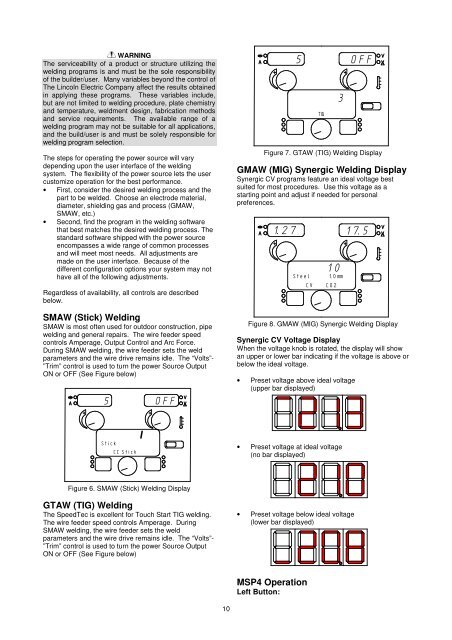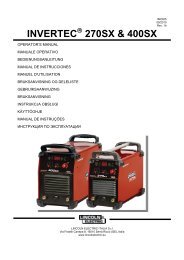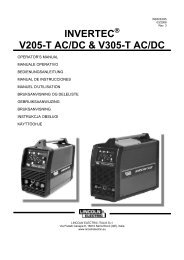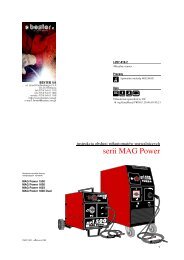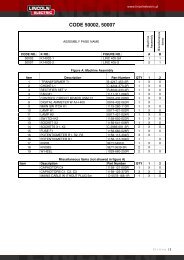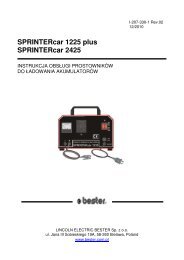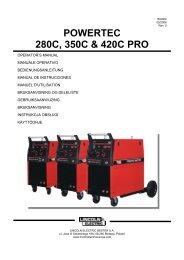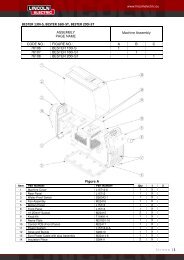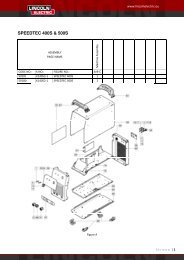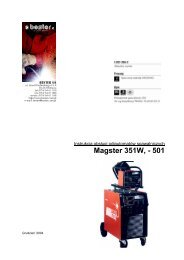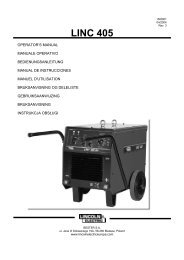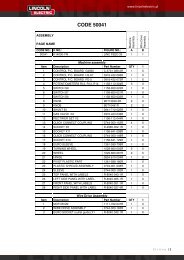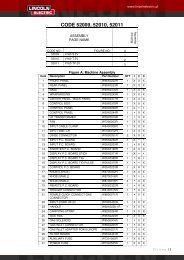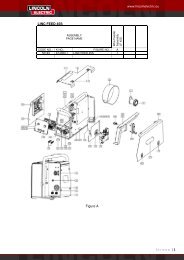LINC FEED 45 - Lincoln Electric - documentations
LINC FEED 45 - Lincoln Electric - documentations
LINC FEED 45 - Lincoln Electric - documentations
You also want an ePaper? Increase the reach of your titles
YUMPU automatically turns print PDFs into web optimized ePapers that Google loves.
WARNING<br />
The serviceability of a product or structure utilizing the<br />
welding programs is and must be the sole responsibility<br />
of the builder/user. Many variables beyond the control of<br />
The <strong>Lincoln</strong> <strong>Electric</strong> Company affect the results obtained<br />
in applying these programs. These variables include,<br />
but are not limited to welding procedure, plate chemistry<br />
and temperature, weldment design, fabrication methods<br />
and service requirements. The available range of a<br />
welding program may not be suitable for all applications,<br />
and the build/user is and must be solely responsible for<br />
welding program selection.<br />
The steps for operating the power source will vary<br />
depending upon the user interface of the welding<br />
system. The flexibility of the power source lets the user<br />
customize operation for the best performance.<br />
• First, consider the desired welding process and the<br />
part to be welded. Choose an electrode material,<br />
diameter, shielding gas and process (GMAW,<br />
SMAW, etc.)<br />
• Second, find the program in the welding software<br />
that best matches the desired welding process. The<br />
standard software shipped with the power source<br />
encompasses a wide range of common processes<br />
and will meet most needs. All adjustments are<br />
made on the user interface. Because of the<br />
different configuration options your system may not<br />
have all of the following adjustments.<br />
Regardless of availability, all controls are described<br />
below.<br />
SMAW (Stick) Welding<br />
SMAW is most often used for outdoor construction, pipe<br />
welding and general repairs. The wire feeder speed<br />
controls Amperage, Output Control and Arc Force.<br />
During SMAW welding, the wire feeder sets the weld<br />
parameters and the wire drive remains idle. The “Volts”-<br />
”Trim” control is used to turn the power Source Output<br />
ON or OFF (See Figure below)<br />
<br />
<br />
<br />
<br />
<br />
Figure 7. GTAW (TIG) Welding Display<br />
GMAW (MIG) Synergic Welding Display<br />
Synergic CV programs feature an ideal voltage best<br />
suited for most procedures. Use this voltage as a<br />
starting point and adjust if needed for personal<br />
preferences.<br />
<br />
<br />
<br />
<br />
<br />
<br />
Figure 8. GMAW (MIG) Synergic Welding Display<br />
Synergic CV Voltage Display<br />
When the voltage knob is rotated, the display will show<br />
an upper or lower bar indicating if the voltage is above or<br />
below the ideal voltage.<br />
• Preset voltage above ideal voltage<br />
(upper bar displayed)<br />
<br />
<br />
• Preset voltage at ideal voltage<br />
(no bar displayed)<br />
Figure 6. SMAW (Stick) Welding Display<br />
GTAW (TIG) Welding<br />
The SpeedTec is excellent for Touch Start TIG welding.<br />
The wire feeder speed controls Amperage. During<br />
SMAW welding, the wire feeder sets the weld<br />
parameters and the wire drive remains idle. The “Volts”-<br />
”Trim” control is used to turn the power Source Output<br />
ON or OFF (See Figure below)<br />
• Preset voltage below ideal voltage<br />
(lower bar displayed)<br />
MSP4 Operation<br />
Left Button:<br />
10


